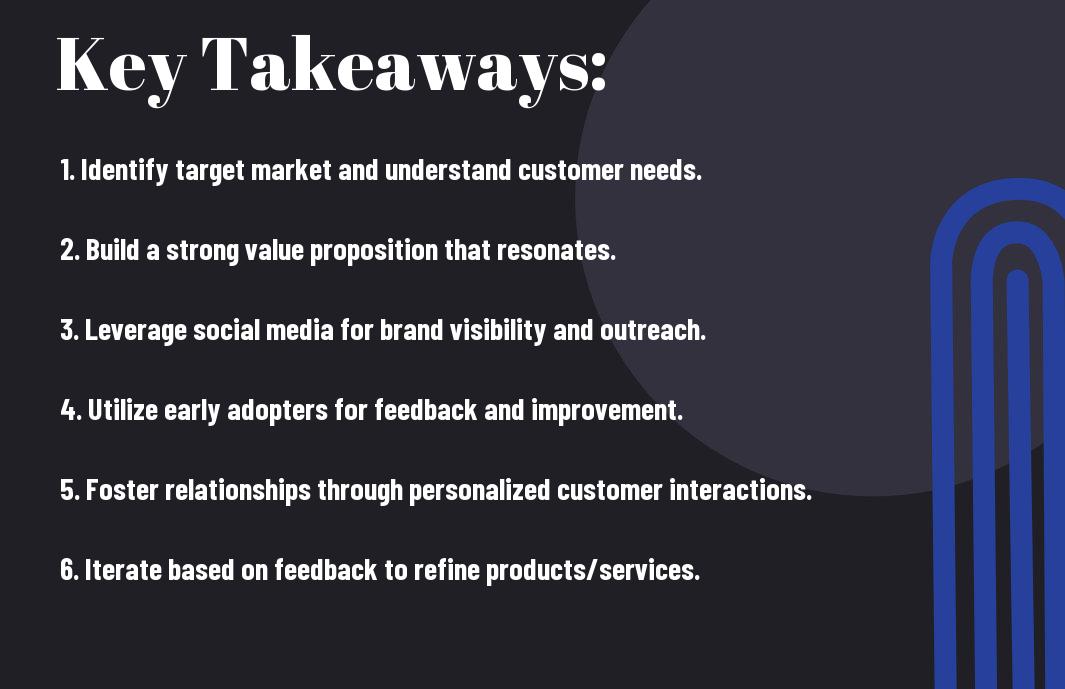
Startups often face the daunting challenge of acquiring their first customers. Understanding what it takes to attract, engage, and retain your initial user base is key. In this post, I’ll share the vital strategies and insights I’ve learned from my own experiences, enabling you to build a strong foundation for your startup. By focusing on effective outreach, creating value, and leveraging feedback, I’ll help you navigate the path from zero to your first 100 customers, ensuring a sustainable growth trajectory for your business.
Key Takeaways:
- Identifying and understanding your target audience is necessary for tailoring your marketing efforts and product features to meet their needs effectively.
- Leverage various channels for customer acquisition, including social media, networking events, and content marketing, to create a diverse approach that maximizes outreach.
- Focus on building relationships with early customers to foster loyalty and gather valuable feedback that can guide product improvements and drive referrals.

Understanding Your Target Market
Before launching your startup, it’s vital to have a deep understanding of your target market. Gaining insights into who your potential customers are allows you to tailor your offerings to meet their needs effectively. By conducting thorough research, you will be able to identify the unique characteristics, preferences, and behaviors of your audience, which can significantly influence your marketing strategy and product development.
Identifying Customer Pain Points
Below, I discuss the importance of pinpointing the specific challenges and frustrations faced by your target customers. Understanding their pain points helps you create solutions that not only address these issues but also position your product as a vital resource, enhancing customer satisfaction and loyalty.
Building Customer Personas
Behind the scenes, creating detailed customer personas helps you visualize your ideal customer. By gathering demographic information, interests, and buying behaviors, you can tailor your marketing strategies to better resonate with your audience.
For instance, when building customer personas, I gather information such as age, gender, income level, and lifestyle choices. This data helps me pinpoint the specific needs and preferences of my audience. Additionally, I research into their motivations and pain points to enhance my product offerings. By developing these comprehensive profiles, you not only create targeted marketing campaigns, but also foster a connection with customers, ultimately driving sales and cultivating long-term relationships.
Crafting Your Unique Value Proposition
The core of any successful startup lies in a well-defined Unique Value Proposition (UVP). This essence captures what makes your product or service stand out, helping you connect with your target audience. Crafting a compelling UVP is imperative for attracting those first 100 customers, as it clearly articulates how you solve their problems better than anyone else.
Differentiating From Competitors
Value is the key to differentiating your offering from competitors. By identifying your unique strengths and understanding the market landscape, I can emphasize what sets my brand apart. This requires in-depth research into competitor offerings and pinpointing gaps or unmet needs that my product can address directly, ultimately giving customers reasons to choose me over others.
Communicating Value Effectively
Among the many strategies for attracting customers, effectively communicating your value is paramount. Your audience must quickly understand not only what you offer but also why it matters to them. This means I need to present my UVP clearly and compellingly through various channels, such as your website, social media, and marketing materials. Making this message consistent and engaging helps build trust and draws potential customers in.
And, to effectively communicate value, I must use clear language that resonates with your target audience’s needs and preferences. Whether through compelling visuals, persuasive storytelling, or customer testimonials, finding innovative ways to highlight the benefits of my offering is imperative. The aim is to create a strong emotional connection, ensuring that my audience understands the practical value and the transformational impact my product or service can provide, leading them to choose my brand over others.
Marketing Strategies for Early Growth
All successful startups must adopt effective marketing strategies to accelerate early growth. By identifying and implementing the right techniques, you can engage your target audience and convert them into loyal customers. In this chapter, I will outline key strategies to help you establish a solid marketing foundation and gain traction quickly.
Leveraging Social Media
Growth in today’s market relies heavily on harnessing the power of social media platforms. By consistently engaging with your audience, sharing relatable content, and using targeted advertisements, you can create meaningful connections and drive traffic to your business.
Utilizing Content Marketing
Content plays a significant role in drawing potential customers to your brand and building trust. Crafting valuable blog posts, informative videos, and engaging infographics not only showcases your expertise but also enhances your brand recognition.
In addition to building trust, utilizing content marketing allows you to showcase your unique selling proposition. By delivering high-quality content consistently, you can attract organic traffic, improve your search engine rankings, and ultimately convert readers into customers. Be sure to promote your content through various platforms to amplify its reach; the more visibility you gain, the more potential customers you can attract.
Building a Sales Pipeline
Many new startups struggle with establishing a reliable sales pipeline. To effectively convert prospects into loyal customers, it’s crucial to create a systematic approach that allows you to track interactions, follow-ups, and conversion rates. This organized structure will not only help streamline your sales process but also ensure that you’re consistently nurturing leads at every stage of their buyer’s journey.
Strategies for Lead Generation
On your path to gaining your first 100 customers, employing diverse strategies for lead generation is key. Utilize social media, email marketing, and content creation to attract potential customers. Partnering with influencers within your niche can broaden your reach, while hosting webinars or workshops can serve as effective platforms for capturing leads. Always analyze which strategies yield the best results to refine your approach.
Converting Leads to Customers
Any successful strategy must focus on converting leads into paying customers. This involves understanding their needs, communicating your value proposition clearly, and addressing any objections they may have. Create personalized follow-up sequences that inspire trust and confidence, ultimately guiding them to make the purchase decision.
Hence, building strong relationships with your leads is paramount for conversion success. You need to foster an environment where their concerns are heard and understood. Providing personalized solutions shows that you value their unique needs. Be prepared to answer questions promptly and convincingly, demonstrating that you are the best option for solving their problems. Through persistent, yet respectful communication, you can turn those leads into loyal customers, ensuring your startup reaches its early milestones effectively.
Engaging and Retaining Your First Customers
Unlike established businesses, new startups face the challenge of building trust and loyalty from scratch. Engaging your first customers isn’t just about making a sale; it’s about creating ongoing relationships that convert them into brand advocates. By implementing strategies for connection, you not only keep them coming back but also encourage them to share their experiences, ultimately expanding your customer base.
Providing Excellent Customer Service
One of the best ways to win over your initial customers is by offering excellent customer service. Prompt responses, personalized interactions, and genuine care for their needs can set your startup apart. When customers feel valued and understood, they’re more likely to return and recommend your service to others.
Encouraging Customer Feedback
Across your journey, it’s vital to encourage customer feedback. This not only helps you understand what you’re doing well but also highlights areas for improvement.
With an open line for feedback, you can gather valuable insights that shape the future of your startup. Asking for feedback shows customers that you value their opinion, fostering a sense of involvement. It’s imperative to act on the feedback received—this demonstrates your commitment to improvement and can lead to enhanced customer satisfaction. Engaging with your customers about their concerns or suggestions creates a positive feedback loop that can ultimately lead to loyal, long-term supporters of your brand.

Measuring Success and Adapting Strategies
Not all metrics indicate success in the same way. As a startup, I find it necessary to closely monitor performance and adapt my strategies based on these insights. Tracking the right data will help you pivot effectively, ensuring your business grows in the right direction.
Key Performance Indicators (KPIs)
After identifying your startup’s goals, I recommend selecting specific Key Performance Indicators (KPIs) to measure progress. These metrics can include customer acquisition costs, churn rates, and engagement levels. By consistently evaluating these indicators, you can align your efforts, optimize resources, and make informed decisions that drive growth.
Iterating Based on Data
Along the path to growth, analyzing the data you collect is vital. It allows me to assess what works and what doesn’t, offering insights into customer preferences and market trends.
Strategies must evolve as I gather more information. By actively analyzing key metrics, I’m able to identify patterns and refine my offerings, effectively addressing customer pain points. This iterative process not only helps in enhancing the product but also in optimizing marketing efforts. If I notice a particular approach isn’t resonating with customers, I can quickly pivot, saving time and resources while improving overall strategies to align closer with their needs. The data-driven approach fosters a culture of continuous improvement, enabling my startup to stay agile and competitive.
Conclusion
Summing up, I believe that mastering the journey from zero to your first 100 customers is vital for any new startup. By implementing the strategies outlined in this blueprint, you can effectively engage your target audience, refine your offerings, and build a loyal customer base. Every interaction you have with potential customers offers valuable insights that will shape your business’s future. Use this framework as your guide to navigate the complexities of entrepreneurship, and you’ll find success is within your reach.
Leave a Reply